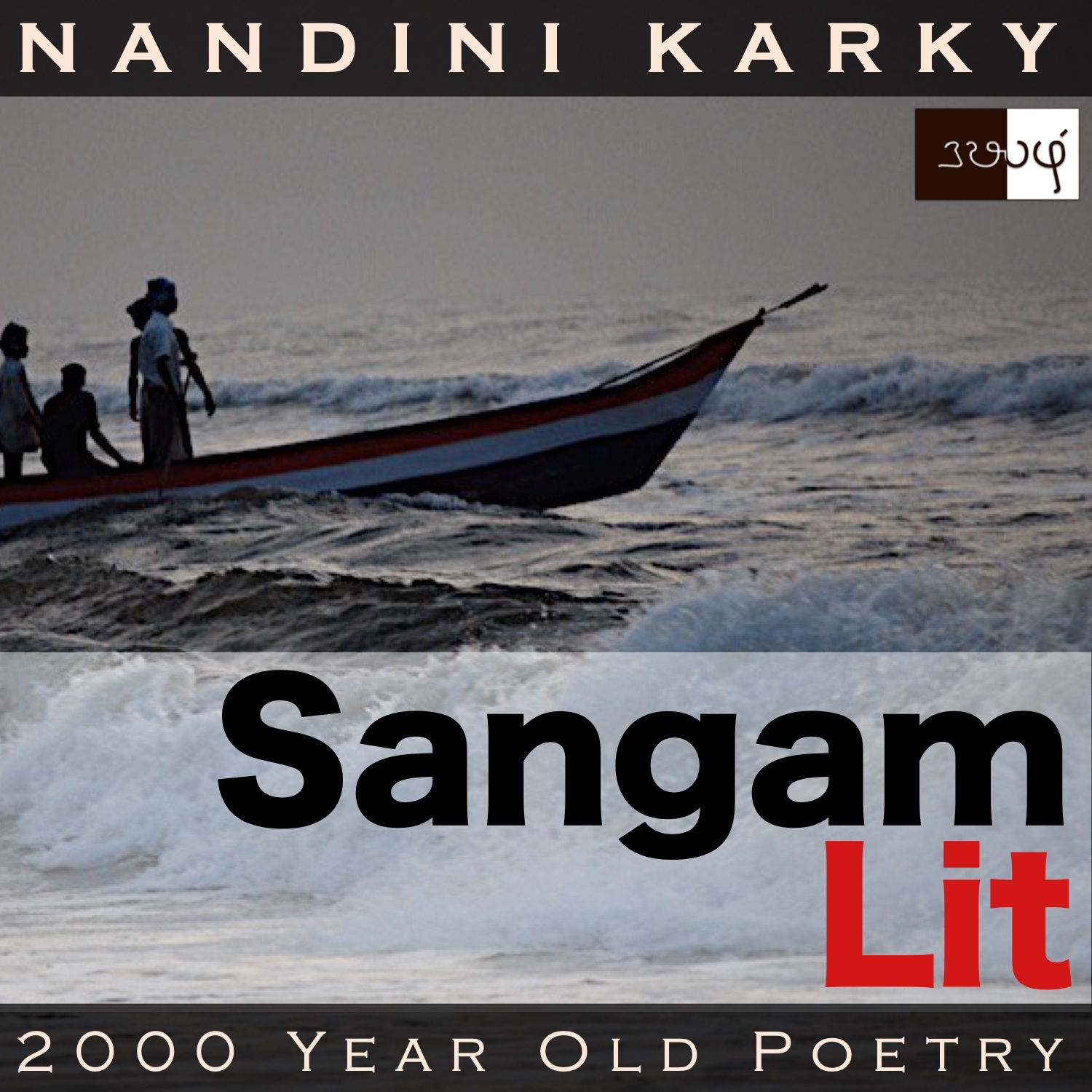Podcast: Play in new window | Download
Subscribe: Apple Podcasts | Spotify | Amazon Music | Android | iHeartRadio | TuneIn | RSS | More

In this episode, we perceive the life of fisherfolk and the dreams it reflects, as portrayed in Sangam Literary work, Natrinai 388, penned by Madurai Marutham Kizhaar Makanaar Perunkannanaar. Set in the coastal regions of ‘Neythal’, the verse speaks in the voice of the lady to the confidante, passing on a hidden message to the man, listening nearby.
அம்ம வாழி, தோழி!-நன்னுதற்கு
யாங்கு ஆகின்றுகொல் பசப்பே-நோன் புரிக்
கயிறு கடை யாத்த கடு நடை எறி உளித்
திண் திமில் பரதவர் ஒண் சுடர்க் கொளீஇ,
நடு நாள் வேட்டம் போகி, வைகறைக்
கடல் மீன் தந்து, கானற் குவைஇ,
ஓங்கு இரும் புன்னை வரி நிழல் இருந்து,
தேம் கமழ் தேறல் கிளையொடு மாந்தி,
பெரிய மகிழும் துறைவன் எம்
சிறிய நெஞ்சத்து அகல்வு அறியானே?
The verse opens with ‘அம்ம வாழி, தோழி’ meaning ‘Listen, may you live long, my friend’ and highlights the two most frequently used words in Sangam literature, wherein we perceive this gentle custom of rendering a blessing to a person, whose attention is sought. Symptoms of pining that we are well-versed with, can be seen on the ‘நன்னுதல்’ meaning ‘fine forehead’ and ‘பசப்பு’ or ‘pining’. From these elements of inner life, the verse turns to the outer world in ‘திண் திமில் பரதவர்’ meaning ‘fisherfolk with sturdy boats’, also talking about their occupation of ‘நடு நாள் வேட்டம்’ or ‘hunting at midnight’. The much-loved tree of the shore soars in ‘ஓங்கு இரும் புன்னை’ meaning ‘tall, dark laurelwood tree’. A food relished by those ancient folk is revealed in ‘தேம் கமழ் தேறல்’ meaning ‘clear toddy, which smells like honey’. Ending with ‘சிறிய நெஞ்சத்து அகல்வு அறியானே’ meaning ‘he who does not know how to part from my little heart’, the verse invites us to explore more!
The man and lady had been leading a love relationship and the man had been trysting for a while. The confidante starts to worry about his lack of intention in formalising the union and the consequences this would have on the lady’s health. Perceiving the worry in her friend’s heart, one day when the man arrives by her house, making sure he’s listening, the lady says to the confidante, “Listen, my friend! May you live long. Carrying fast-moving throw-spears tied to strong, twisted ropes and holding glowing lamps, fisherfolk on sturdy boats hunt for fish at midnight. Returning at dawn with a rich catch, they heap the fish in the seashore grove and then, sitting under the lined shade of the tall, dark ‘punnai’, they relish honey-fragrant toddy with their kith and kin. Such is the joy on the great shores of the lord. When he knows not how to part from my little heart, how can pallor form on my fine forehead?” With these words, the lady allays the fear in her confidante’s heart and at the same time, expresses her wish for the man to expedite seeking her hand in marriage.
Now, for the nuances! The lady starts by seeking her friend’s attention and then puts forth a rhetorical question, asking how could pallor form on her forehead. She doesn’t explain why this is an impossible event and turns instead to talk about fishermen in the man’s shores. This description sounds much like an excavation report. The first artefact discovered here is a strong, twisted rope and at the end of this rope, we can find the outline of sharp spear. To the initiated eye, its aerodynamics would reveal that it can move fast and strike with accuracy. Searching more about this object, I found that it could refer to a harpoon used in spear fishing. Researchers indicate that evidence of this method of hunting with harpoons has been found among the ancient natives of Andaman and Nicobar Islands. The next item on the list is a portion of boat, made with such powerful material that it could weather any storm. Close to this, lies a lamp and this tells us that these fishermen were used to hunting at night. As we continue on the trail of these artefacts, under the shade of a ‘punnai’ tree, we find objects with traces of ancient liquor. The probability of finding these elements that too, in an area by a seashore, is remote but it’s this gap these Sangam verses fill with their detailed description of life then.
Returning to the verse, the lady has thus captured in picture perfect terms, the life of fishermen who hunt by the night and bring back a rich catch of fish by dawn. Then, they take to merriment after their hard work, by joining together with their kith and kin, and having a sweet-scented drink of toddy. The lady has brought in this scene to describe the man’s great shores. Then, she contrasts her little heart with that and concludes by saying that the man does not know how to part away even a little from that heart of hers. With this, she connects back to the question in the beginning, when she asked how ever could pallor form on her forehead. It’s because her heart will not let the man part, there is no cause for that pallor of pining to colour her forehead. At the same time, within the description of fishermen returning with a rich catch of fish and celebrating with their relatives, the lady places as a metaphor, the wish in her heart for the man to gather wealth towards their wedding, heap it in front of her kith and kin and marry her to the merriment of one and all. In one shot, the lady wipes away the anxiety in her friend’s heart and at the same time, reveals her love for the man and nudges him to bring permanent joy to them both. Fascinating how a few lines of a verse can reveal so many layers of the mind like an expert psychologist and at the same time, throw light on the life of ancient people like a skilful archaeologist!




Share your thoughts...